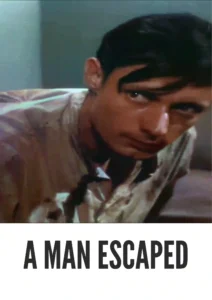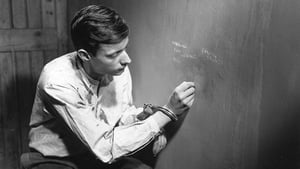Contact: info@alwanfilm.com
Video Sources 0 Views
- Watch trailer
- A Man Escaped


Synopsis
Table of Contents
ToggleCaptivating Cinematic Mastery: A Review of A Man Escaped 1956 Colorized

Introduction
In the realm of classic cinema, few films possess the arresting intensity and raw emotional power of “A Man Escaped” (1956). Directed by the acclaimed Robert Bresson, this gripping tale of resilience and redemption stands as a testament to the enduring power of the human spirit. In this review, we delve into the depths of this timeless masterpiece, exploring its significance, its impact on cinema, and the controversy surrounding its colorization.
Check The Full Colorized Movies List
Check Our Colorized Movies Trailer Channel
Understanding A Man Escaped 1956 Colorized: Director, Cast, and Genre
Directed by Robert Bresson, known for his minimalist approach to filmmaking, “A Man Escaped” epitomizes the director’s distinctive style. The film stars François Leterrier in the lead role of Fontaine, a French Resistance fighter imprisoned by the Nazis during World War II. Leterrier’s understated yet compelling performance anchors the film, drawing viewers into Fontaine’s harrowing journey of survival.
Set against the backdrop of a Nazi prison in occupied France, “A Man Escaped” navigates the genre of war drama with unmatched precision. Bresson’s meticulous attention to detail and unflinching portrayal of the human condition elevate the film beyond mere storytelling, immersing audiences in a world of suspense and tension.
Exploring the World of A Man Escaped 1956 Colorized: Plot and Characters
At its core, “A Man Escaped” is a tale of hope and defiance in the face of overwhelming odds. The film follows Fontaine’s meticulous plan to escape from captivity, relying on his wits and resourcefulness to outmaneuver his captors. As Fontaine forms alliances with fellow prisoners and navigates the treacherous terrain of the prison, he confronts his own fears and vulnerabilities, emerging as a symbol of resilience and courage.
Bresson’s masterful storytelling unfolds with measured precision, immersing viewers in the claustrophobic confines of the prison while building tension with each passing moment. Fontaine’s internal struggle mirrors the larger themes of oppression and liberation, inviting audiences to contemplate the nature of freedom and the sacrifices required to attain it.
The Art of Film Colorization
As with many classic films, “A Man Escaped” was originally shot in black and white, a choice that contributed to its stark visual aesthetic and timeless appeal. However, in recent years, there has been a growing trend towards colorizing classic films, with the aim of making them more accessible to contemporary audiences.
Early Colored Films: A Brief History
The practice of colorizing black and white films dates back to the early days of cinema, with filmmakers experimenting with various techniques to add color to their works. However, it was not until the advent of digital technology that colorization became more widespread, leading to debates about its artistic merit and impact on the integrity of the original films.
A Man Escaped 1956 and Its Early Colored Version
In recent years, “A Man Escaped” has been the subject of colorization efforts, with some versions of the film released in a colorized format. While the intention may have been to attract new audiences and breathe new life into the classic film, the decision to colorize “A Man Escaped” has been met with mixed reactions from critics and audiences alike.
The Debate Over Film Colorization
The debate over film colorization is a contentious one, with proponents arguing that it allows classic films to reach a wider audience and be appreciated by modern viewers who may be put off by black and white cinematography. However, opponents contend that colorization compromises the artistic integrity of the original films, altering the director’s intended vision and detracting from the viewing experience.
Examining A Man Escaped 1956 as an Early Colored Film
For purists, the idea of colorizing “A Man Escaped” may seem sacrilegious, as it risks diluting the film’s impact and distorting its intended meaning. Indeed, the stark contrast between light and shadow, so integral to Bresson’s visual style, may be lost in translation when rendered in color. However, for those less concerned with artistic fidelity, the colorized version of “A Man Escaped” may offer a new perspective on the classic film, allowing audiences to engage with it in a fresh and innovative way.
Influence and Legacy: A Man Escaped 1956’s Impact on Cinema
“A Man Escaped” has left an indelible mark on cinema, inspiring countless filmmakers with its powerful storytelling and innovative approach to visual storytelling. Bresson’s influence can be seen in the work of directors such as Martin Scorsese, who has cited the film as a major influence on his own filmmaking style.
Director’s Cinematic Legacy: Beyond A Man Escaped 1956 Colorized
Beyond “A Man Escaped,” Robert Bresson’s cinematic legacy continues to resonate with audiences and filmmakers alike. His uncompromising vision and commitment to artistic excellence have cemented his status as one of the most influential directors in cinema history, inspiring generations of filmmakers to push the boundaries of the medium.
Themes Explored in A Man Escaped 1956 Colorized
At its core, “A Man Escaped” is a meditation on the nature of freedom and the resilience of the human spirit in the face of adversity. Through Fontaine’s journey, the film explores themes of survival, sacrifice, and redemption, inviting audiences to reflect on the universal struggle for liberation in all its forms.
Reception and Controversy Surrounding A Man Escaped 1956 Colorized
Upon its release, “A Man Escaped” received widespread critical acclaim, with many praising its taut suspense, atmospheric cinematography, and Leterrier’s captivating performance. However, the decision to colorize the film has sparked controversy among cinephiles, with some arguing that it undermines the film’s artistic integrity while others see it as a necessary evolution in the preservation of classic cinema.
Where to Watch A Man Escaped 1956 Colorized Online
For those eager to experience the timeless brilliance of “A Man Escaped,” the film is readily available on popular streaming platforms such as Amazon Prime Video and Criterion Channel, both in its original black and white format and in colorized versions for those curious to see the film through a new lens.
FAQs About A Man Escaped 1956 Colorized
- Is “A Man Escaped” based on a true story?
- Yes, the film is based on the memoirs of André Devigny, a French Resistance fighter who escaped from a Nazi prison during World War II.
- What is the significance of the film’s title?
- The title “A Man Escaped” refers to the central premise of the film, namely Fontaine’s daring escape from captivity.
- Does the colorization of the film detract from its artistic value?
- Opinions on the colorization of “A Man Escaped” vary, with some arguing that it offers a new perspective on the classic film while others believe it compromises the director’s original vision.
Conclusion
In conclusion, “A Man Escaped” stands as a testament to the enduring power of cinema to captivate and inspire audiences across generations. Whether viewed in its original black and white format or in a colorized version, the film’s message of hope and resilience continues to resonate with viewers, reminding us of the indomitable spirit of the human soul in the face of adversity. As we navigate the ever-changing landscape of film preservation and restoration, let us continue to cherish and celebrate the timeless brilliance of classics like “A Man Escaped,” ensuring that their legacy endures for generations to come.








